Comprehensive Analysis: Research Methods in Education Assignment
VerifiedAdded on 2022/08/29
|27
|9005
|14
Homework Assignment
AI Summary
This assignment solution for Research Methods in Education provides a comprehensive analysis of a research article on effective educational leadership practices. It addresses questions on research design, including the selection of a quasi-experimental design, and discusses threats to internal validity. The solution also explores the creation of an attitude scale to measure attitudes towards the death sentence and includes a detailed design for a survey on internet usage, covering sample selection, research questions, demographic variables, and questionnaire design. The solution emphasizes the importance of statistical analysis, equivalent groups, and provides a complete overview of the research process, from literature review to data collection and analysis.
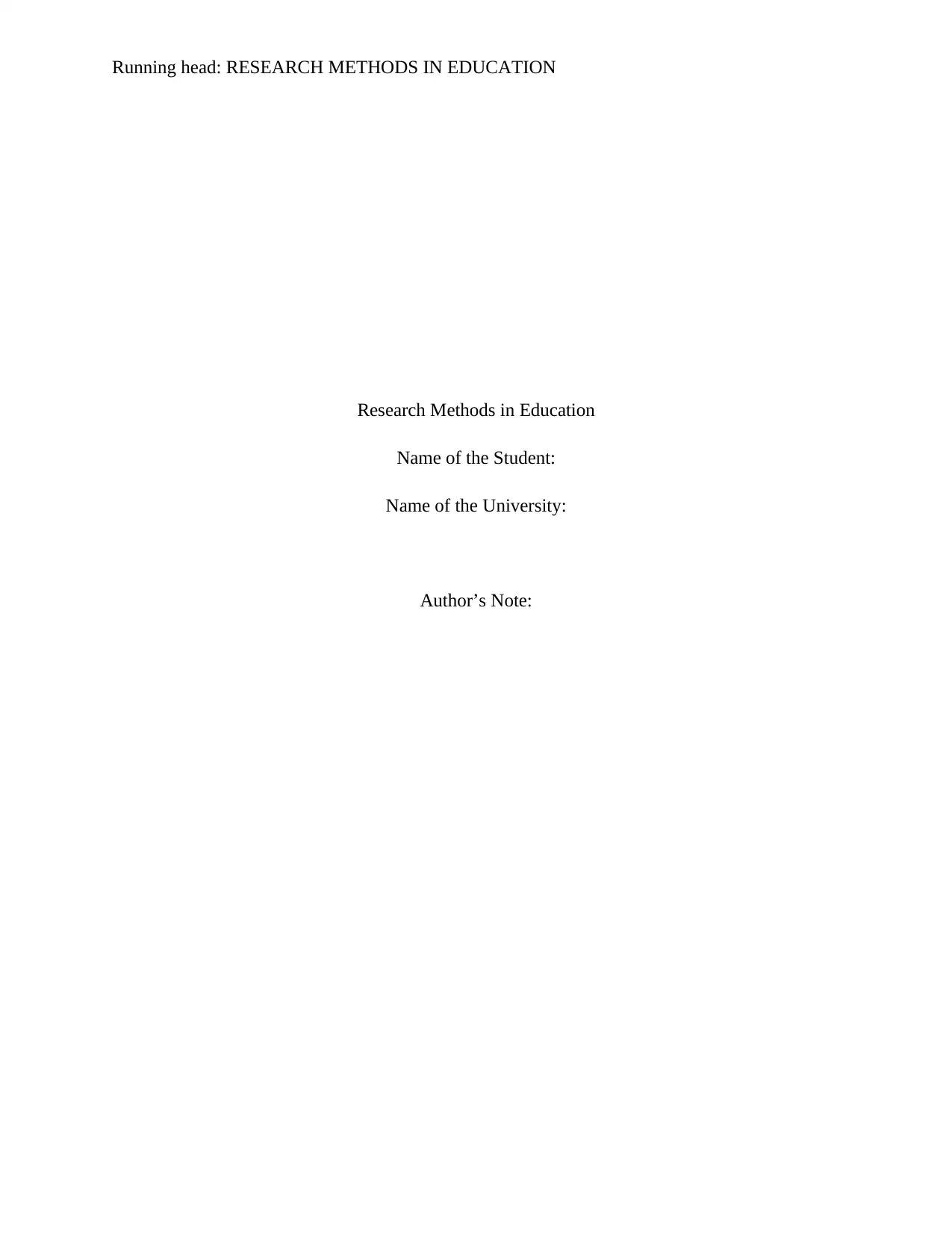
Running head: RESEARCH METHODS IN EDUCATION
Research Methods in Education
Name of the Student:
Name of the University:
Author’s Note:
Research Methods in Education
Name of the Student:
Name of the University:
Author’s Note:
Paraphrase This Document
Need a fresh take? Get an instant paraphrase of this document with our AI Paraphraser
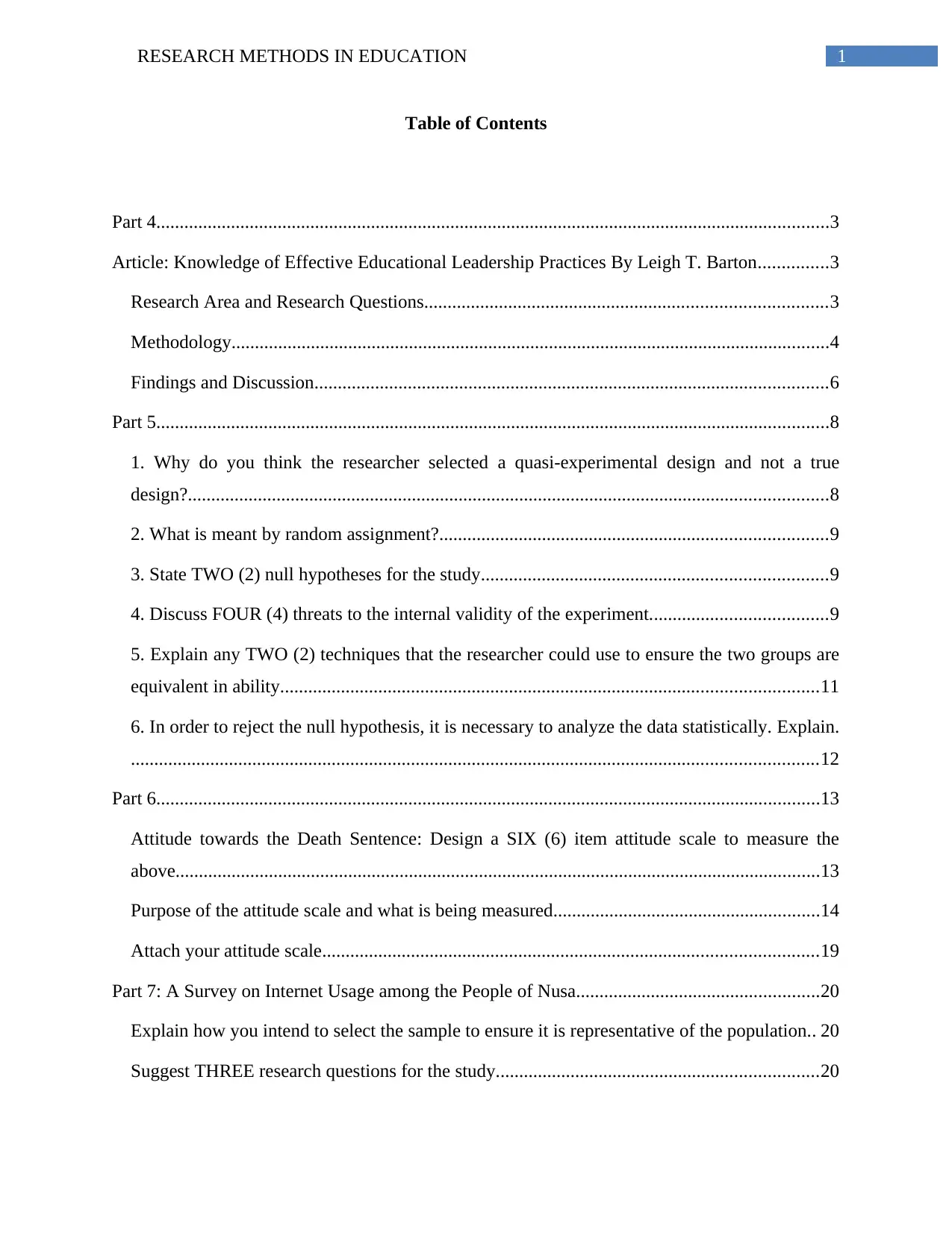
1RESEARCH METHODS IN EDUCATION
Table of Contents
Part 4................................................................................................................................................3
Article: Knowledge of Effective Educational Leadership Practices By Leigh T. Barton...............3
Research Area and Research Questions......................................................................................3
Methodology................................................................................................................................4
Findings and Discussion..............................................................................................................6
Part 5................................................................................................................................................8
1. Why do you think the researcher selected a quasi-experimental design and not a true
design?.........................................................................................................................................8
2. What is meant by random assignment?...................................................................................9
3. State TWO (2) null hypotheses for the study..........................................................................9
4. Discuss FOUR (4) threats to the internal validity of the experiment......................................9
5. Explain any TWO (2) techniques that the researcher could use to ensure the two groups are
equivalent in ability...................................................................................................................11
6. In order to reject the null hypothesis, it is necessary to analyze the data statistically. Explain.
...................................................................................................................................................12
Part 6..............................................................................................................................................13
Attitude towards the Death Sentence: Design a SIX (6) item attitude scale to measure the
above..........................................................................................................................................13
Purpose of the attitude scale and what is being measured.........................................................14
Attach your attitude scale..........................................................................................................19
Part 7: A Survey on Internet Usage among the People of Nusa....................................................20
Explain how you intend to select the sample to ensure it is representative of the population.. 20
Suggest THREE research questions for the study.....................................................................20
Table of Contents
Part 4................................................................................................................................................3
Article: Knowledge of Effective Educational Leadership Practices By Leigh T. Barton...............3
Research Area and Research Questions......................................................................................3
Methodology................................................................................................................................4
Findings and Discussion..............................................................................................................6
Part 5................................................................................................................................................8
1. Why do you think the researcher selected a quasi-experimental design and not a true
design?.........................................................................................................................................8
2. What is meant by random assignment?...................................................................................9
3. State TWO (2) null hypotheses for the study..........................................................................9
4. Discuss FOUR (4) threats to the internal validity of the experiment......................................9
5. Explain any TWO (2) techniques that the researcher could use to ensure the two groups are
equivalent in ability...................................................................................................................11
6. In order to reject the null hypothesis, it is necessary to analyze the data statistically. Explain.
...................................................................................................................................................12
Part 6..............................................................................................................................................13
Attitude towards the Death Sentence: Design a SIX (6) item attitude scale to measure the
above..........................................................................................................................................13
Purpose of the attitude scale and what is being measured.........................................................14
Attach your attitude scale..........................................................................................................19
Part 7: A Survey on Internet Usage among the People of Nusa....................................................20
Explain how you intend to select the sample to ensure it is representative of the population.. 20
Suggest THREE research questions for the study.....................................................................20
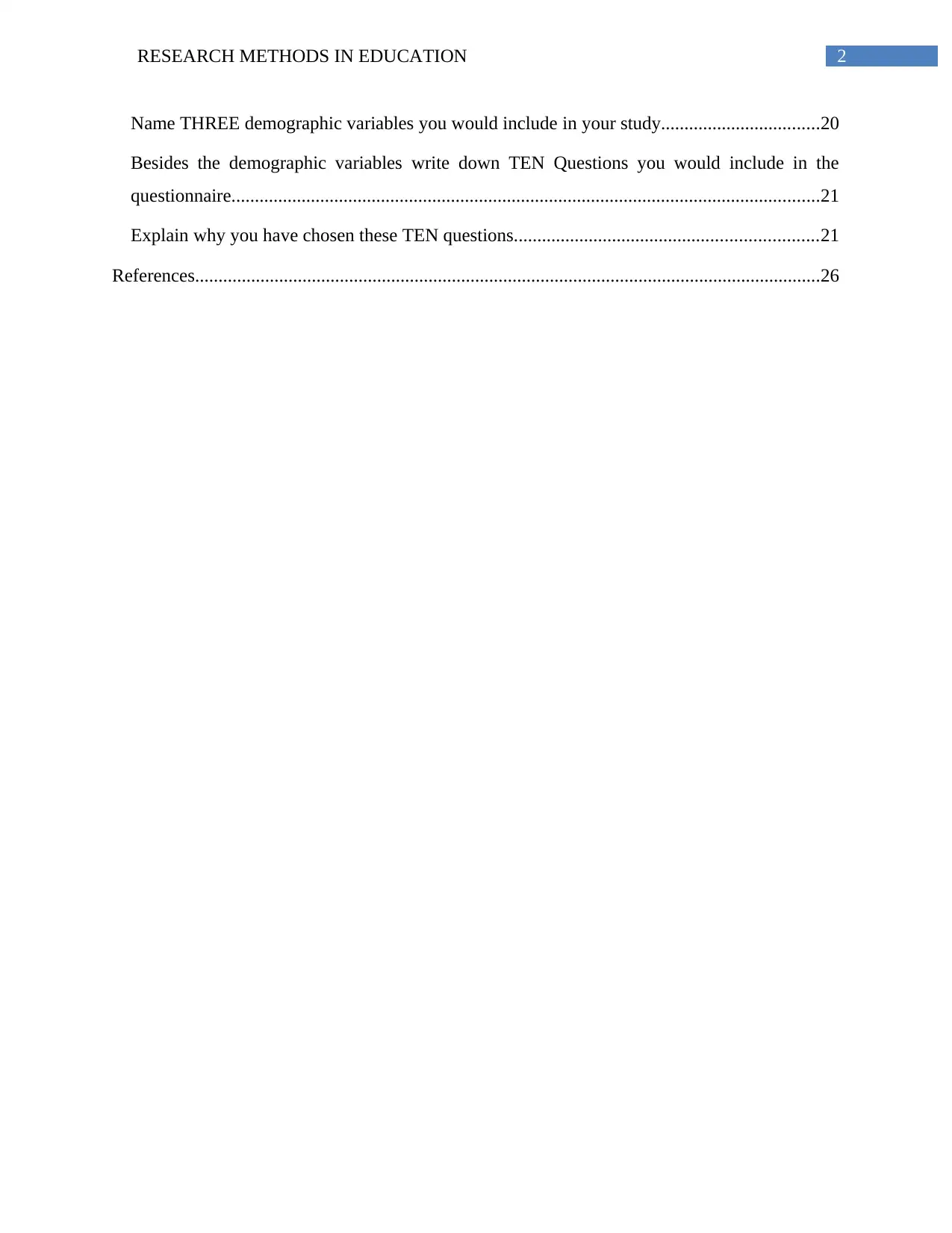
2RESEARCH METHODS IN EDUCATION
Name THREE demographic variables you would include in your study..................................20
Besides the demographic variables write down TEN Questions you would include in the
questionnaire..............................................................................................................................21
Explain why you have chosen these TEN questions.................................................................21
References......................................................................................................................................26
Name THREE demographic variables you would include in your study..................................20
Besides the demographic variables write down TEN Questions you would include in the
questionnaire..............................................................................................................................21
Explain why you have chosen these TEN questions.................................................................21
References......................................................................................................................................26
⊘ This is a preview!⊘
Do you want full access?
Subscribe today to unlock all pages.

Trusted by 1+ million students worldwide
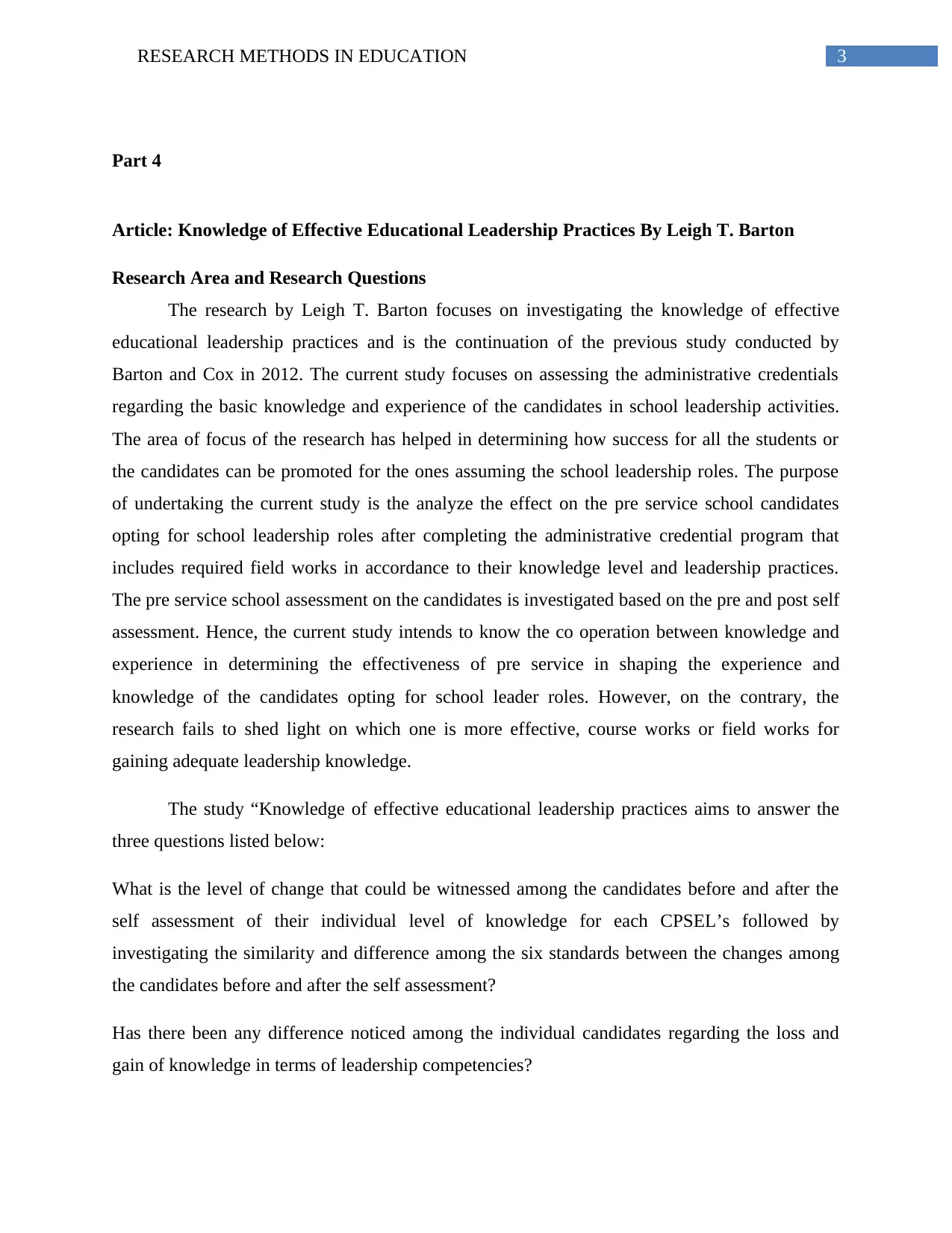
3RESEARCH METHODS IN EDUCATION
Part 4
Article: Knowledge of Effective Educational Leadership Practices By Leigh T. Barton
Research Area and Research Questions
The research by Leigh T. Barton focuses on investigating the knowledge of effective
educational leadership practices and is the continuation of the previous study conducted by
Barton and Cox in 2012. The current study focuses on assessing the administrative credentials
regarding the basic knowledge and experience of the candidates in school leadership activities.
The area of focus of the research has helped in determining how success for all the students or
the candidates can be promoted for the ones assuming the school leadership roles. The purpose
of undertaking the current study is the analyze the effect on the pre service school candidates
opting for school leadership roles after completing the administrative credential program that
includes required field works in accordance to their knowledge level and leadership practices.
The pre service school assessment on the candidates is investigated based on the pre and post self
assessment. Hence, the current study intends to know the co operation between knowledge and
experience in determining the effectiveness of pre service in shaping the experience and
knowledge of the candidates opting for school leader roles. However, on the contrary, the
research fails to shed light on which one is more effective, course works or field works for
gaining adequate leadership knowledge.
The study “Knowledge of effective educational leadership practices aims to answer the
three questions listed below:
What is the level of change that could be witnessed among the candidates before and after the
self assessment of their individual level of knowledge for each CPSEL’s followed by
investigating the similarity and difference among the six standards between the changes among
the candidates before and after the self assessment?
Has there been any difference noticed among the individual candidates regarding the loss and
gain of knowledge in terms of leadership competencies?
Part 4
Article: Knowledge of Effective Educational Leadership Practices By Leigh T. Barton
Research Area and Research Questions
The research by Leigh T. Barton focuses on investigating the knowledge of effective
educational leadership practices and is the continuation of the previous study conducted by
Barton and Cox in 2012. The current study focuses on assessing the administrative credentials
regarding the basic knowledge and experience of the candidates in school leadership activities.
The area of focus of the research has helped in determining how success for all the students or
the candidates can be promoted for the ones assuming the school leadership roles. The purpose
of undertaking the current study is the analyze the effect on the pre service school candidates
opting for school leadership roles after completing the administrative credential program that
includes required field works in accordance to their knowledge level and leadership practices.
The pre service school assessment on the candidates is investigated based on the pre and post self
assessment. Hence, the current study intends to know the co operation between knowledge and
experience in determining the effectiveness of pre service in shaping the experience and
knowledge of the candidates opting for school leader roles. However, on the contrary, the
research fails to shed light on which one is more effective, course works or field works for
gaining adequate leadership knowledge.
The study “Knowledge of effective educational leadership practices aims to answer the
three questions listed below:
What is the level of change that could be witnessed among the candidates before and after the
self assessment of their individual level of knowledge for each CPSEL’s followed by
investigating the similarity and difference among the six standards between the changes among
the candidates before and after the self assessment?
Has there been any difference noticed among the individual candidates regarding the loss and
gain of knowledge in terms of leadership competencies?
Paraphrase This Document
Need a fresh take? Get an instant paraphrase of this document with our AI Paraphraser
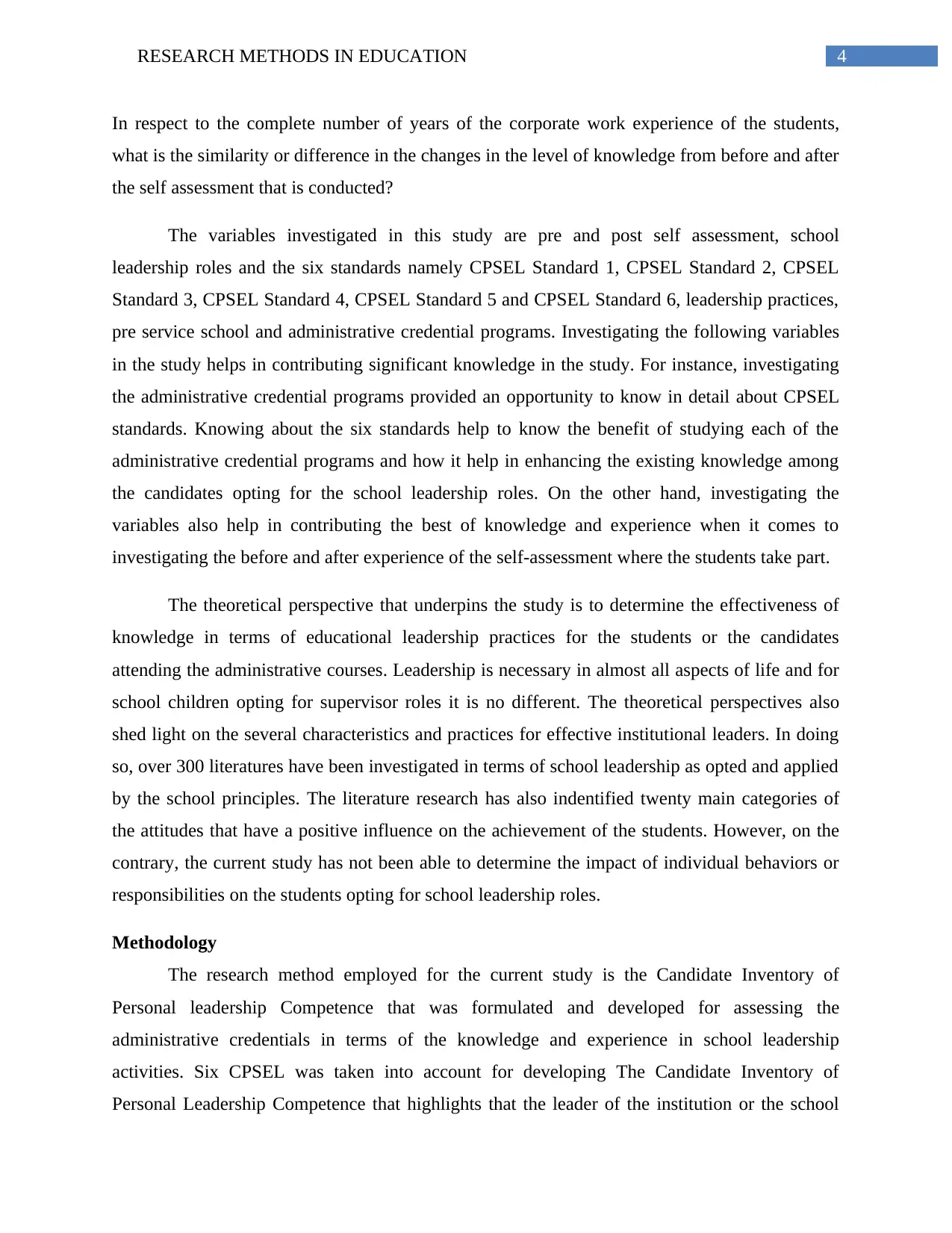
4RESEARCH METHODS IN EDUCATION
In respect to the complete number of years of the corporate work experience of the students,
what is the similarity or difference in the changes in the level of knowledge from before and after
the self assessment that is conducted?
The variables investigated in this study are pre and post self assessment, school
leadership roles and the six standards namely CPSEL Standard 1, CPSEL Standard 2, CPSEL
Standard 3, CPSEL Standard 4, CPSEL Standard 5 and CPSEL Standard 6, leadership practices,
pre service school and administrative credential programs. Investigating the following variables
in the study helps in contributing significant knowledge in the study. For instance, investigating
the administrative credential programs provided an opportunity to know in detail about CPSEL
standards. Knowing about the six standards help to know the benefit of studying each of the
administrative credential programs and how it help in enhancing the existing knowledge among
the candidates opting for the school leadership roles. On the other hand, investigating the
variables also help in contributing the best of knowledge and experience when it comes to
investigating the before and after experience of the self-assessment where the students take part.
The theoretical perspective that underpins the study is to determine the effectiveness of
knowledge in terms of educational leadership practices for the students or the candidates
attending the administrative courses. Leadership is necessary in almost all aspects of life and for
school children opting for supervisor roles it is no different. The theoretical perspectives also
shed light on the several characteristics and practices for effective institutional leaders. In doing
so, over 300 literatures have been investigated in terms of school leadership as opted and applied
by the school principles. The literature research has also indentified twenty main categories of
the attitudes that have a positive influence on the achievement of the students. However, on the
contrary, the current study has not been able to determine the impact of individual behaviors or
responsibilities on the students opting for school leadership roles.
Methodology
The research method employed for the current study is the Candidate Inventory of
Personal leadership Competence that was formulated and developed for assessing the
administrative credentials in terms of the knowledge and experience in school leadership
activities. Six CPSEL was taken into account for developing The Candidate Inventory of
Personal Leadership Competence that highlights that the leader of the institution or the school
In respect to the complete number of years of the corporate work experience of the students,
what is the similarity or difference in the changes in the level of knowledge from before and after
the self assessment that is conducted?
The variables investigated in this study are pre and post self assessment, school
leadership roles and the six standards namely CPSEL Standard 1, CPSEL Standard 2, CPSEL
Standard 3, CPSEL Standard 4, CPSEL Standard 5 and CPSEL Standard 6, leadership practices,
pre service school and administrative credential programs. Investigating the following variables
in the study helps in contributing significant knowledge in the study. For instance, investigating
the administrative credential programs provided an opportunity to know in detail about CPSEL
standards. Knowing about the six standards help to know the benefit of studying each of the
administrative credential programs and how it help in enhancing the existing knowledge among
the candidates opting for the school leadership roles. On the other hand, investigating the
variables also help in contributing the best of knowledge and experience when it comes to
investigating the before and after experience of the self-assessment where the students take part.
The theoretical perspective that underpins the study is to determine the effectiveness of
knowledge in terms of educational leadership practices for the students or the candidates
attending the administrative courses. Leadership is necessary in almost all aspects of life and for
school children opting for supervisor roles it is no different. The theoretical perspectives also
shed light on the several characteristics and practices for effective institutional leaders. In doing
so, over 300 literatures have been investigated in terms of school leadership as opted and applied
by the school principles. The literature research has also indentified twenty main categories of
the attitudes that have a positive influence on the achievement of the students. However, on the
contrary, the current study has not been able to determine the impact of individual behaviors or
responsibilities on the students opting for school leadership roles.
Methodology
The research method employed for the current study is the Candidate Inventory of
Personal leadership Competence that was formulated and developed for assessing the
administrative credentials in terms of the knowledge and experience in school leadership
activities. Six CPSEL was taken into account for developing The Candidate Inventory of
Personal Leadership Competence that highlights that the leader of the institution or the school
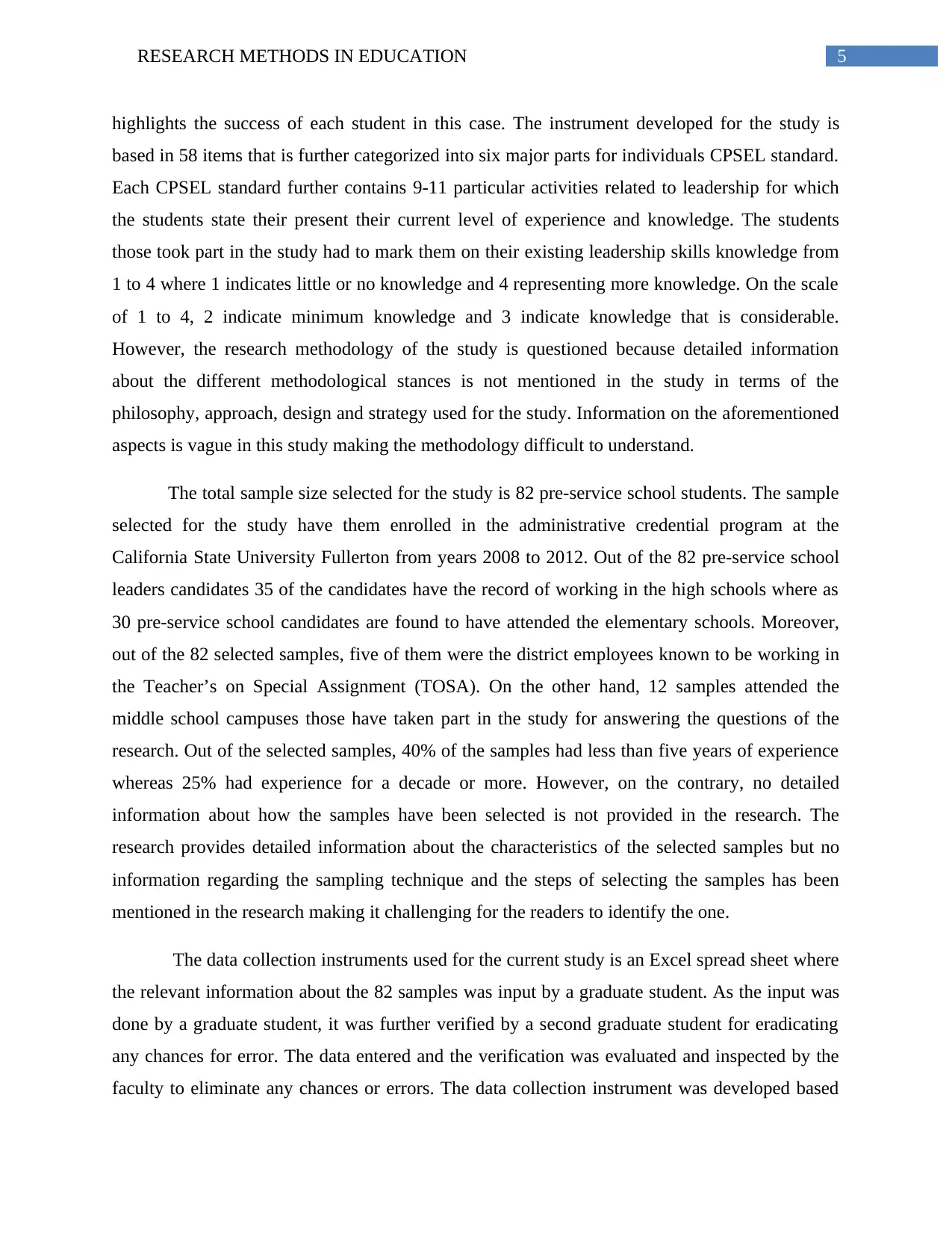
5RESEARCH METHODS IN EDUCATION
highlights the success of each student in this case. The instrument developed for the study is
based in 58 items that is further categorized into six major parts for individuals CPSEL standard.
Each CPSEL standard further contains 9-11 particular activities related to leadership for which
the students state their present their current level of experience and knowledge. The students
those took part in the study had to mark them on their existing leadership skills knowledge from
1 to 4 where 1 indicates little or no knowledge and 4 representing more knowledge. On the scale
of 1 to 4, 2 indicate minimum knowledge and 3 indicate knowledge that is considerable.
However, the research methodology of the study is questioned because detailed information
about the different methodological stances is not mentioned in the study in terms of the
philosophy, approach, design and strategy used for the study. Information on the aforementioned
aspects is vague in this study making the methodology difficult to understand.
The total sample size selected for the study is 82 pre-service school students. The sample
selected for the study have them enrolled in the administrative credential program at the
California State University Fullerton from years 2008 to 2012. Out of the 82 pre-service school
leaders candidates 35 of the candidates have the record of working in the high schools where as
30 pre-service school candidates are found to have attended the elementary schools. Moreover,
out of the 82 selected samples, five of them were the district employees known to be working in
the Teacher’s on Special Assignment (TOSA). On the other hand, 12 samples attended the
middle school campuses those have taken part in the study for answering the questions of the
research. Out of the selected samples, 40% of the samples had less than five years of experience
whereas 25% had experience for a decade or more. However, on the contrary, no detailed
information about how the samples have been selected is not provided in the research. The
research provides detailed information about the characteristics of the selected samples but no
information regarding the sampling technique and the steps of selecting the samples has been
mentioned in the research making it challenging for the readers to identify the one.
The data collection instruments used for the current study is an Excel spread sheet where
the relevant information about the 82 samples was input by a graduate student. As the input was
done by a graduate student, it was further verified by a second graduate student for eradicating
any chances for error. The data entered and the verification was evaluated and inspected by the
faculty to eliminate any chances or errors. The data collection instrument was developed based
highlights the success of each student in this case. The instrument developed for the study is
based in 58 items that is further categorized into six major parts for individuals CPSEL standard.
Each CPSEL standard further contains 9-11 particular activities related to leadership for which
the students state their present their current level of experience and knowledge. The students
those took part in the study had to mark them on their existing leadership skills knowledge from
1 to 4 where 1 indicates little or no knowledge and 4 representing more knowledge. On the scale
of 1 to 4, 2 indicate minimum knowledge and 3 indicate knowledge that is considerable.
However, the research methodology of the study is questioned because detailed information
about the different methodological stances is not mentioned in the study in terms of the
philosophy, approach, design and strategy used for the study. Information on the aforementioned
aspects is vague in this study making the methodology difficult to understand.
The total sample size selected for the study is 82 pre-service school students. The sample
selected for the study have them enrolled in the administrative credential program at the
California State University Fullerton from years 2008 to 2012. Out of the 82 pre-service school
leaders candidates 35 of the candidates have the record of working in the high schools where as
30 pre-service school candidates are found to have attended the elementary schools. Moreover,
out of the 82 selected samples, five of them were the district employees known to be working in
the Teacher’s on Special Assignment (TOSA). On the other hand, 12 samples attended the
middle school campuses those have taken part in the study for answering the questions of the
research. Out of the selected samples, 40% of the samples had less than five years of experience
whereas 25% had experience for a decade or more. However, on the contrary, no detailed
information about how the samples have been selected is not provided in the research. The
research provides detailed information about the characteristics of the selected samples but no
information regarding the sampling technique and the steps of selecting the samples has been
mentioned in the research making it challenging for the readers to identify the one.
The data collection instruments used for the current study is an Excel spread sheet where
the relevant information about the 82 samples was input by a graduate student. As the input was
done by a graduate student, it was further verified by a second graduate student for eradicating
any chances for error. The data entered and the verification was evaluated and inspected by the
faculty to eliminate any chances or errors. The data collection instrument was developed based
⊘ This is a preview!⊘
Do you want full access?
Subscribe today to unlock all pages.

Trusted by 1+ million students worldwide
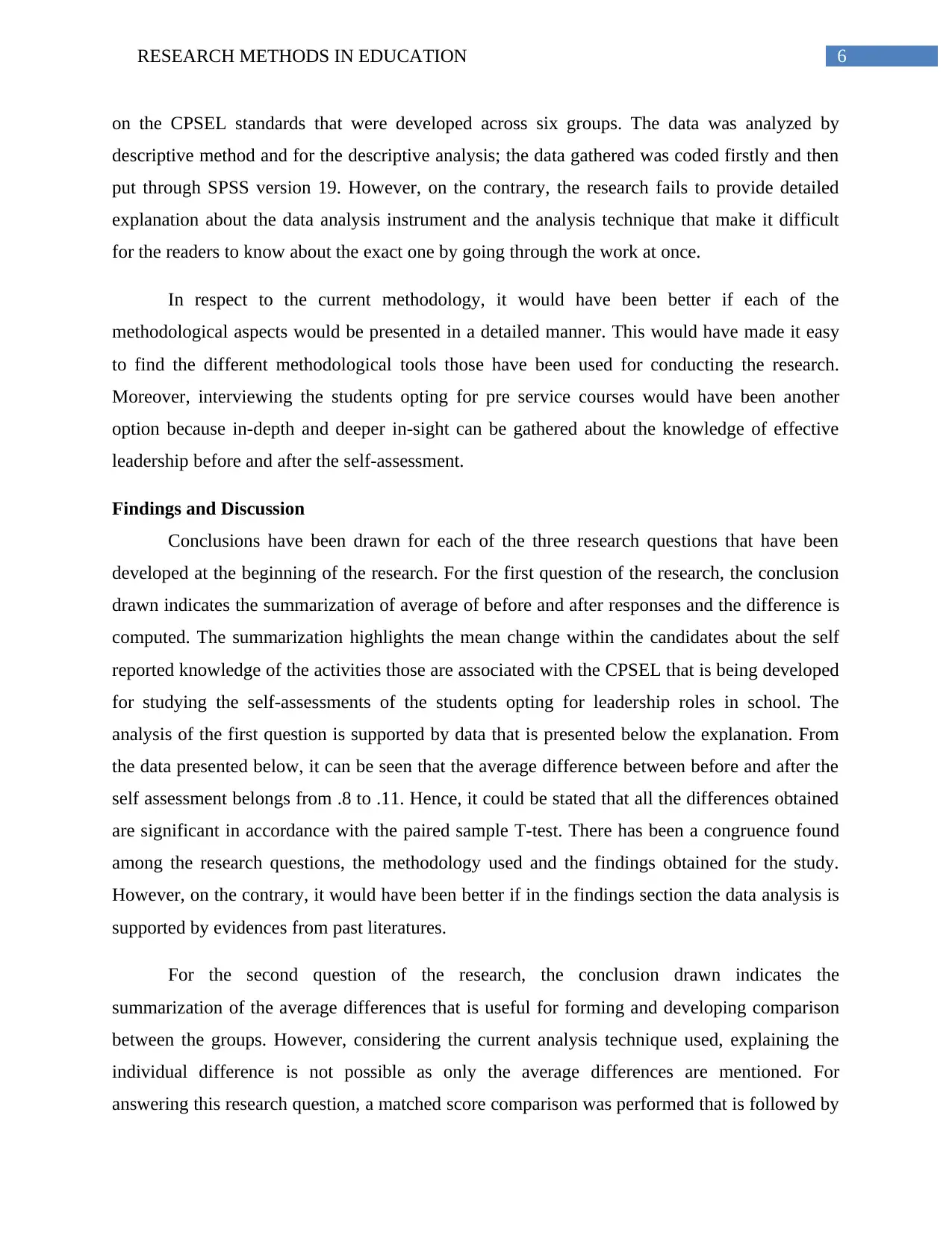
6RESEARCH METHODS IN EDUCATION
on the CPSEL standards that were developed across six groups. The data was analyzed by
descriptive method and for the descriptive analysis; the data gathered was coded firstly and then
put through SPSS version 19. However, on the contrary, the research fails to provide detailed
explanation about the data analysis instrument and the analysis technique that make it difficult
for the readers to know about the exact one by going through the work at once.
In respect to the current methodology, it would have been better if each of the
methodological aspects would be presented in a detailed manner. This would have made it easy
to find the different methodological tools those have been used for conducting the research.
Moreover, interviewing the students opting for pre service courses would have been another
option because in-depth and deeper in-sight can be gathered about the knowledge of effective
leadership before and after the self-assessment.
Findings and Discussion
Conclusions have been drawn for each of the three research questions that have been
developed at the beginning of the research. For the first question of the research, the conclusion
drawn indicates the summarization of average of before and after responses and the difference is
computed. The summarization highlights the mean change within the candidates about the self
reported knowledge of the activities those are associated with the CPSEL that is being developed
for studying the self-assessments of the students opting for leadership roles in school. The
analysis of the first question is supported by data that is presented below the explanation. From
the data presented below, it can be seen that the average difference between before and after the
self assessment belongs from .8 to .11. Hence, it could be stated that all the differences obtained
are significant in accordance with the paired sample T-test. There has been a congruence found
among the research questions, the methodology used and the findings obtained for the study.
However, on the contrary, it would have been better if in the findings section the data analysis is
supported by evidences from past literatures.
For the second question of the research, the conclusion drawn indicates the
summarization of the average differences that is useful for forming and developing comparison
between the groups. However, considering the current analysis technique used, explaining the
individual difference is not possible as only the average differences are mentioned. For
answering this research question, a matched score comparison was performed that is followed by
on the CPSEL standards that were developed across six groups. The data was analyzed by
descriptive method and for the descriptive analysis; the data gathered was coded firstly and then
put through SPSS version 19. However, on the contrary, the research fails to provide detailed
explanation about the data analysis instrument and the analysis technique that make it difficult
for the readers to know about the exact one by going through the work at once.
In respect to the current methodology, it would have been better if each of the
methodological aspects would be presented in a detailed manner. This would have made it easy
to find the different methodological tools those have been used for conducting the research.
Moreover, interviewing the students opting for pre service courses would have been another
option because in-depth and deeper in-sight can be gathered about the knowledge of effective
leadership before and after the self-assessment.
Findings and Discussion
Conclusions have been drawn for each of the three research questions that have been
developed at the beginning of the research. For the first question of the research, the conclusion
drawn indicates the summarization of average of before and after responses and the difference is
computed. The summarization highlights the mean change within the candidates about the self
reported knowledge of the activities those are associated with the CPSEL that is being developed
for studying the self-assessments of the students opting for leadership roles in school. The
analysis of the first question is supported by data that is presented below the explanation. From
the data presented below, it can be seen that the average difference between before and after the
self assessment belongs from .8 to .11. Hence, it could be stated that all the differences obtained
are significant in accordance with the paired sample T-test. There has been a congruence found
among the research questions, the methodology used and the findings obtained for the study.
However, on the contrary, it would have been better if in the findings section the data analysis is
supported by evidences from past literatures.
For the second question of the research, the conclusion drawn indicates the
summarization of the average differences that is useful for forming and developing comparison
between the groups. However, considering the current analysis technique used, explaining the
individual difference is not possible as only the average differences are mentioned. For
answering this research question, a matched score comparison was performed that is followed by
Paraphrase This Document
Need a fresh take? Get an instant paraphrase of this document with our AI Paraphraser
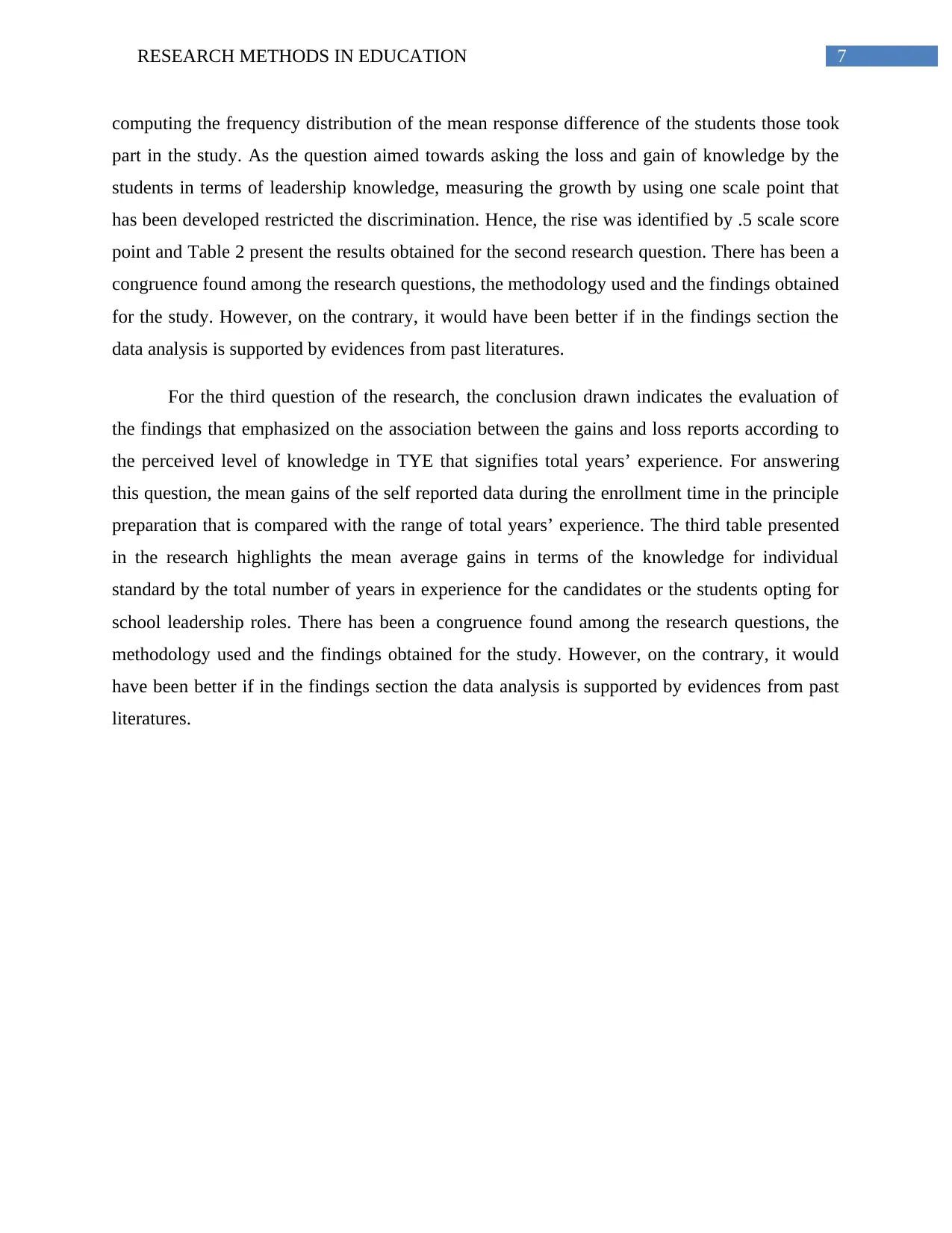
7RESEARCH METHODS IN EDUCATION
computing the frequency distribution of the mean response difference of the students those took
part in the study. As the question aimed towards asking the loss and gain of knowledge by the
students in terms of leadership knowledge, measuring the growth by using one scale point that
has been developed restricted the discrimination. Hence, the rise was identified by .5 scale score
point and Table 2 present the results obtained for the second research question. There has been a
congruence found among the research questions, the methodology used and the findings obtained
for the study. However, on the contrary, it would have been better if in the findings section the
data analysis is supported by evidences from past literatures.
For the third question of the research, the conclusion drawn indicates the evaluation of
the findings that emphasized on the association between the gains and loss reports according to
the perceived level of knowledge in TYE that signifies total years’ experience. For answering
this question, the mean gains of the self reported data during the enrollment time in the principle
preparation that is compared with the range of total years’ experience. The third table presented
in the research highlights the mean average gains in terms of the knowledge for individual
standard by the total number of years in experience for the candidates or the students opting for
school leadership roles. There has been a congruence found among the research questions, the
methodology used and the findings obtained for the study. However, on the contrary, it would
have been better if in the findings section the data analysis is supported by evidences from past
literatures.
computing the frequency distribution of the mean response difference of the students those took
part in the study. As the question aimed towards asking the loss and gain of knowledge by the
students in terms of leadership knowledge, measuring the growth by using one scale point that
has been developed restricted the discrimination. Hence, the rise was identified by .5 scale score
point and Table 2 present the results obtained for the second research question. There has been a
congruence found among the research questions, the methodology used and the findings obtained
for the study. However, on the contrary, it would have been better if in the findings section the
data analysis is supported by evidences from past literatures.
For the third question of the research, the conclusion drawn indicates the evaluation of
the findings that emphasized on the association between the gains and loss reports according to
the perceived level of knowledge in TYE that signifies total years’ experience. For answering
this question, the mean gains of the self reported data during the enrollment time in the principle
preparation that is compared with the range of total years’ experience. The third table presented
in the research highlights the mean average gains in terms of the knowledge for individual
standard by the total number of years in experience for the candidates or the students opting for
school leadership roles. There has been a congruence found among the research questions, the
methodology used and the findings obtained for the study. However, on the contrary, it would
have been better if in the findings section the data analysis is supported by evidences from past
literatures.
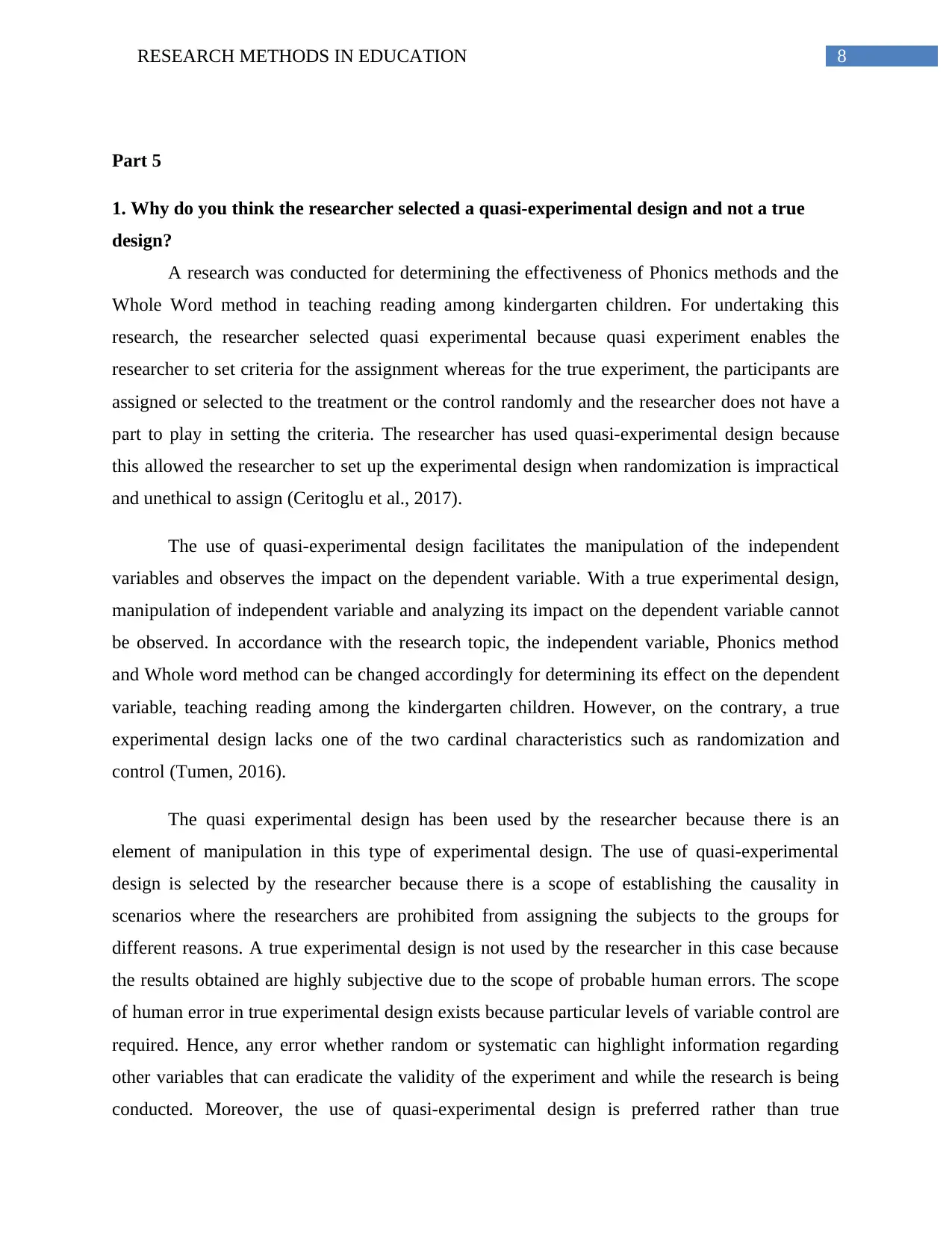
8RESEARCH METHODS IN EDUCATION
Part 5
1. Why do you think the researcher selected a quasi-experimental design and not a true
design?
A research was conducted for determining the effectiveness of Phonics methods and the
Whole Word method in teaching reading among kindergarten children. For undertaking this
research, the researcher selected quasi experimental because quasi experiment enables the
researcher to set criteria for the assignment whereas for the true experiment, the participants are
assigned or selected to the treatment or the control randomly and the researcher does not have a
part to play in setting the criteria. The researcher has used quasi-experimental design because
this allowed the researcher to set up the experimental design when randomization is impractical
and unethical to assign (Ceritoglu et al., 2017).
The use of quasi-experimental design facilitates the manipulation of the independent
variables and observes the impact on the dependent variable. With a true experimental design,
manipulation of independent variable and analyzing its impact on the dependent variable cannot
be observed. In accordance with the research topic, the independent variable, Phonics method
and Whole word method can be changed accordingly for determining its effect on the dependent
variable, teaching reading among the kindergarten children. However, on the contrary, a true
experimental design lacks one of the two cardinal characteristics such as randomization and
control (Tumen, 2016).
The quasi experimental design has been used by the researcher because there is an
element of manipulation in this type of experimental design. The use of quasi-experimental
design is selected by the researcher because there is a scope of establishing the causality in
scenarios where the researchers are prohibited from assigning the subjects to the groups for
different reasons. A true experimental design is not used by the researcher in this case because
the results obtained are highly subjective due to the scope of probable human errors. The scope
of human error in true experimental design exists because particular levels of variable control are
required. Hence, any error whether random or systematic can highlight information regarding
other variables that can eradicate the validity of the experiment and while the research is being
conducted. Moreover, the use of quasi-experimental design is preferred rather than true
Part 5
1. Why do you think the researcher selected a quasi-experimental design and not a true
design?
A research was conducted for determining the effectiveness of Phonics methods and the
Whole Word method in teaching reading among kindergarten children. For undertaking this
research, the researcher selected quasi experimental because quasi experiment enables the
researcher to set criteria for the assignment whereas for the true experiment, the participants are
assigned or selected to the treatment or the control randomly and the researcher does not have a
part to play in setting the criteria. The researcher has used quasi-experimental design because
this allowed the researcher to set up the experimental design when randomization is impractical
and unethical to assign (Ceritoglu et al., 2017).
The use of quasi-experimental design facilitates the manipulation of the independent
variables and observes the impact on the dependent variable. With a true experimental design,
manipulation of independent variable and analyzing its impact on the dependent variable cannot
be observed. In accordance with the research topic, the independent variable, Phonics method
and Whole word method can be changed accordingly for determining its effect on the dependent
variable, teaching reading among the kindergarten children. However, on the contrary, a true
experimental design lacks one of the two cardinal characteristics such as randomization and
control (Tumen, 2016).
The quasi experimental design has been used by the researcher because there is an
element of manipulation in this type of experimental design. The use of quasi-experimental
design is selected by the researcher because there is a scope of establishing the causality in
scenarios where the researchers are prohibited from assigning the subjects to the groups for
different reasons. A true experimental design is not used by the researcher in this case because
the results obtained are highly subjective due to the scope of probable human errors. The scope
of human error in true experimental design exists because particular levels of variable control are
required. Hence, any error whether random or systematic can highlight information regarding
other variables that can eradicate the validity of the experiment and while the research is being
conducted. Moreover, the use of quasi-experimental design is preferred rather than true
⊘ This is a preview!⊘
Do you want full access?
Subscribe today to unlock all pages.

Trusted by 1+ million students worldwide
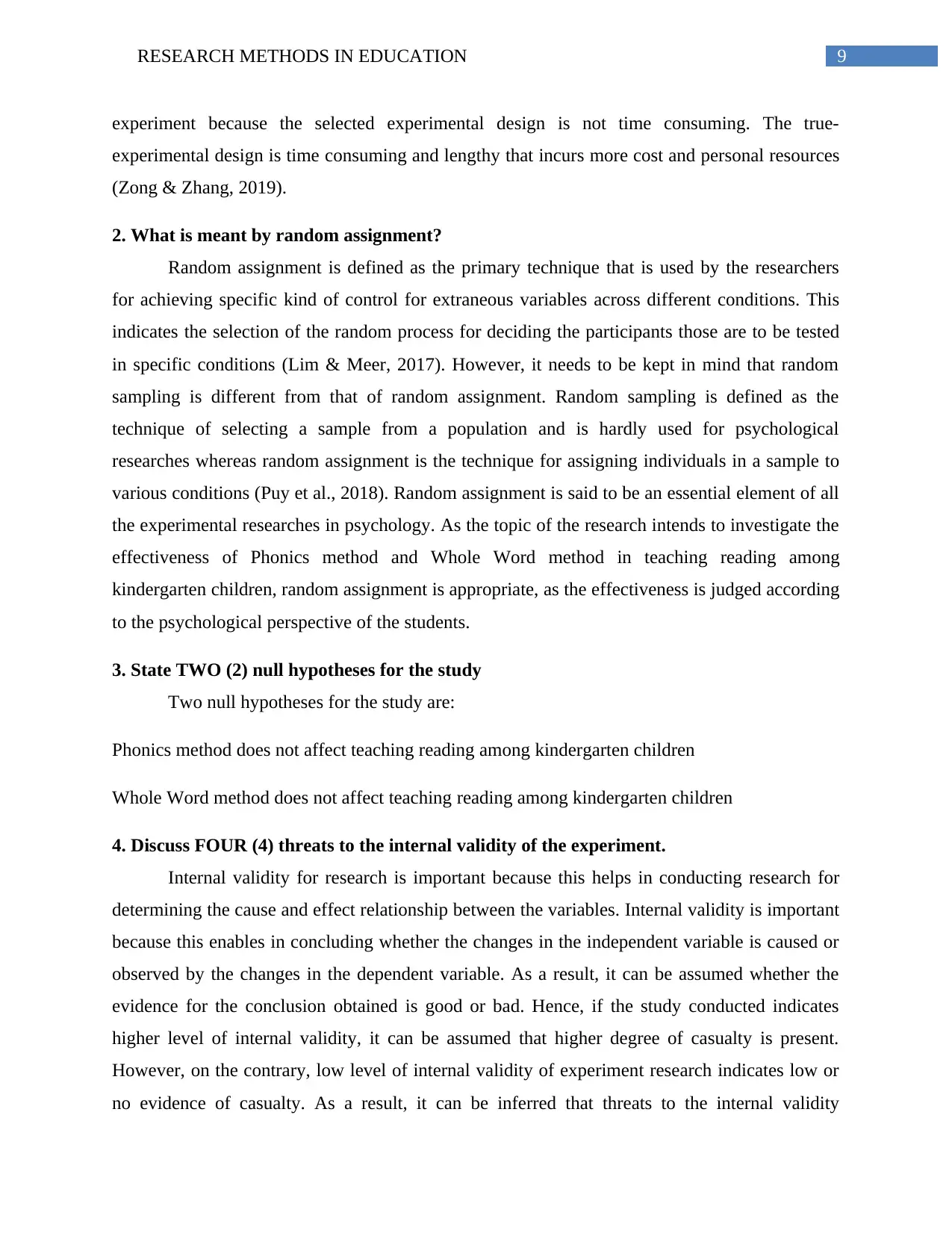
9RESEARCH METHODS IN EDUCATION
experiment because the selected experimental design is not time consuming. The true-
experimental design is time consuming and lengthy that incurs more cost and personal resources
(Zong & Zhang, 2019).
2. What is meant by random assignment?
Random assignment is defined as the primary technique that is used by the researchers
for achieving specific kind of control for extraneous variables across different conditions. This
indicates the selection of the random process for deciding the participants those are to be tested
in specific conditions (Lim & Meer, 2017). However, it needs to be kept in mind that random
sampling is different from that of random assignment. Random sampling is defined as the
technique of selecting a sample from a population and is hardly used for psychological
researches whereas random assignment is the technique for assigning individuals in a sample to
various conditions (Puy et al., 2018). Random assignment is said to be an essential element of all
the experimental researches in psychology. As the topic of the research intends to investigate the
effectiveness of Phonics method and Whole Word method in teaching reading among
kindergarten children, random assignment is appropriate, as the effectiveness is judged according
to the psychological perspective of the students.
3. State TWO (2) null hypotheses for the study
Two null hypotheses for the study are:
Phonics method does not affect teaching reading among kindergarten children
Whole Word method does not affect teaching reading among kindergarten children
4. Discuss FOUR (4) threats to the internal validity of the experiment.
Internal validity for research is important because this helps in conducting research for
determining the cause and effect relationship between the variables. Internal validity is important
because this enables in concluding whether the changes in the independent variable is caused or
observed by the changes in the dependent variable. As a result, it can be assumed whether the
evidence for the conclusion obtained is good or bad. Hence, if the study conducted indicates
higher level of internal validity, it can be assumed that higher degree of casualty is present.
However, on the contrary, low level of internal validity of experiment research indicates low or
no evidence of casualty. As a result, it can be inferred that threats to the internal validity
experiment because the selected experimental design is not time consuming. The true-
experimental design is time consuming and lengthy that incurs more cost and personal resources
(Zong & Zhang, 2019).
2. What is meant by random assignment?
Random assignment is defined as the primary technique that is used by the researchers
for achieving specific kind of control for extraneous variables across different conditions. This
indicates the selection of the random process for deciding the participants those are to be tested
in specific conditions (Lim & Meer, 2017). However, it needs to be kept in mind that random
sampling is different from that of random assignment. Random sampling is defined as the
technique of selecting a sample from a population and is hardly used for psychological
researches whereas random assignment is the technique for assigning individuals in a sample to
various conditions (Puy et al., 2018). Random assignment is said to be an essential element of all
the experimental researches in psychology. As the topic of the research intends to investigate the
effectiveness of Phonics method and Whole Word method in teaching reading among
kindergarten children, random assignment is appropriate, as the effectiveness is judged according
to the psychological perspective of the students.
3. State TWO (2) null hypotheses for the study
Two null hypotheses for the study are:
Phonics method does not affect teaching reading among kindergarten children
Whole Word method does not affect teaching reading among kindergarten children
4. Discuss FOUR (4) threats to the internal validity of the experiment.
Internal validity for research is important because this helps in conducting research for
determining the cause and effect relationship between the variables. Internal validity is important
because this enables in concluding whether the changes in the independent variable is caused or
observed by the changes in the dependent variable. As a result, it can be assumed whether the
evidence for the conclusion obtained is good or bad. Hence, if the study conducted indicates
higher level of internal validity, it can be assumed that higher degree of casualty is present.
However, on the contrary, low level of internal validity of experiment research indicates low or
no evidence of casualty. As a result, it can be inferred that threats to the internal validity
Paraphrase This Document
Need a fresh take? Get an instant paraphrase of this document with our AI Paraphraser
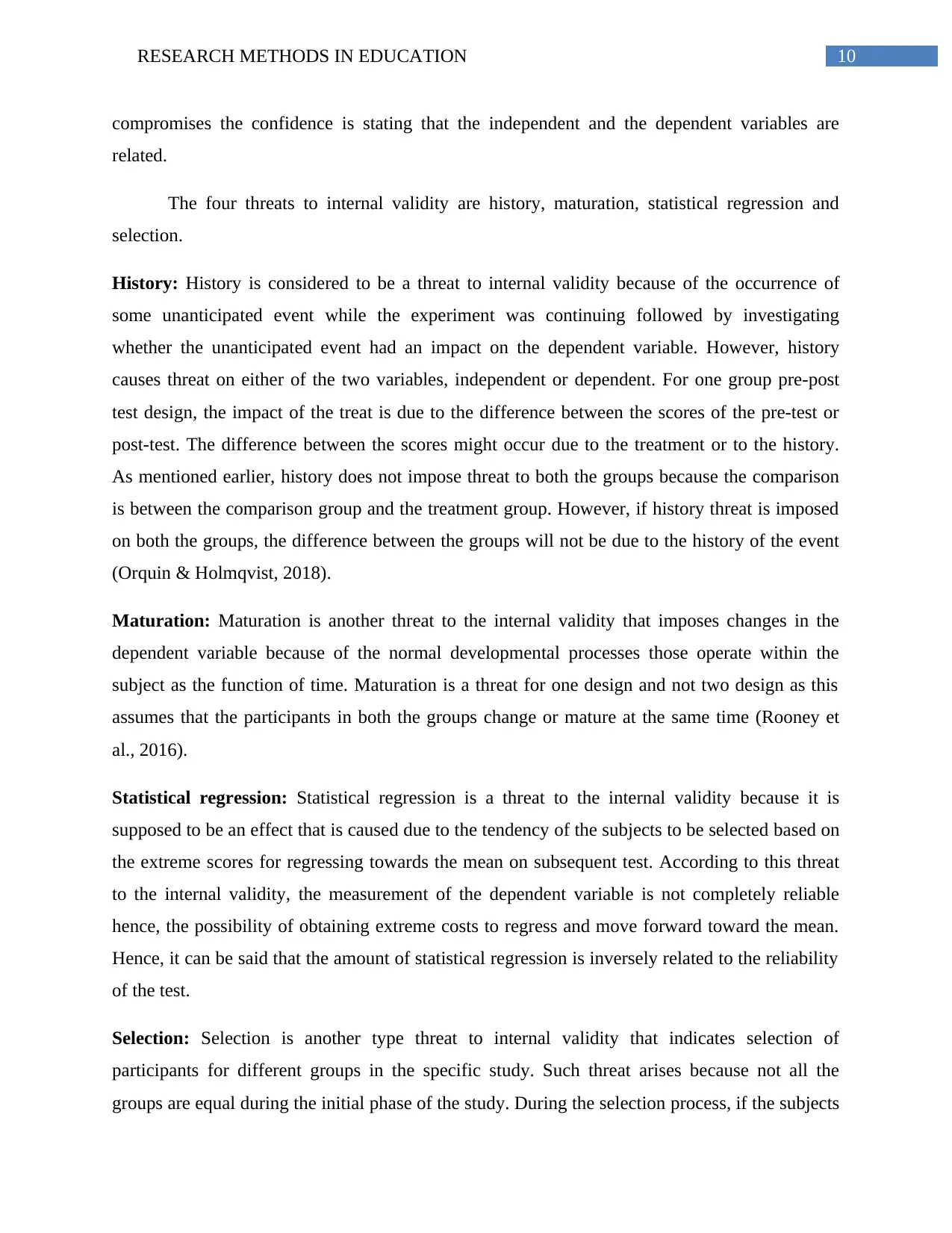
10RESEARCH METHODS IN EDUCATION
compromises the confidence is stating that the independent and the dependent variables are
related.
The four threats to internal validity are history, maturation, statistical regression and
selection.
History: History is considered to be a threat to internal validity because of the occurrence of
some unanticipated event while the experiment was continuing followed by investigating
whether the unanticipated event had an impact on the dependent variable. However, history
causes threat on either of the two variables, independent or dependent. For one group pre-post
test design, the impact of the treat is due to the difference between the scores of the pre-test or
post-test. The difference between the scores might occur due to the treatment or to the history.
As mentioned earlier, history does not impose threat to both the groups because the comparison
is between the comparison group and the treatment group. However, if history threat is imposed
on both the groups, the difference between the groups will not be due to the history of the event
(Orquin & Holmqvist, 2018).
Maturation: Maturation is another threat to the internal validity that imposes changes in the
dependent variable because of the normal developmental processes those operate within the
subject as the function of time. Maturation is a threat for one design and not two design as this
assumes that the participants in both the groups change or mature at the same time (Rooney et
al., 2016).
Statistical regression: Statistical regression is a threat to the internal validity because it is
supposed to be an effect that is caused due to the tendency of the subjects to be selected based on
the extreme scores for regressing towards the mean on subsequent test. According to this threat
to the internal validity, the measurement of the dependent variable is not completely reliable
hence, the possibility of obtaining extreme costs to regress and move forward toward the mean.
Hence, it can be said that the amount of statistical regression is inversely related to the reliability
of the test.
Selection: Selection is another type threat to internal validity that indicates selection of
participants for different groups in the specific study. Such threat arises because not all the
groups are equal during the initial phase of the study. During the selection process, if the subjects
compromises the confidence is stating that the independent and the dependent variables are
related.
The four threats to internal validity are history, maturation, statistical regression and
selection.
History: History is considered to be a threat to internal validity because of the occurrence of
some unanticipated event while the experiment was continuing followed by investigating
whether the unanticipated event had an impact on the dependent variable. However, history
causes threat on either of the two variables, independent or dependent. For one group pre-post
test design, the impact of the treat is due to the difference between the scores of the pre-test or
post-test. The difference between the scores might occur due to the treatment or to the history.
As mentioned earlier, history does not impose threat to both the groups because the comparison
is between the comparison group and the treatment group. However, if history threat is imposed
on both the groups, the difference between the groups will not be due to the history of the event
(Orquin & Holmqvist, 2018).
Maturation: Maturation is another threat to the internal validity that imposes changes in the
dependent variable because of the normal developmental processes those operate within the
subject as the function of time. Maturation is a threat for one design and not two design as this
assumes that the participants in both the groups change or mature at the same time (Rooney et
al., 2016).
Statistical regression: Statistical regression is a threat to the internal validity because it is
supposed to be an effect that is caused due to the tendency of the subjects to be selected based on
the extreme scores for regressing towards the mean on subsequent test. According to this threat
to the internal validity, the measurement of the dependent variable is not completely reliable
hence, the possibility of obtaining extreme costs to regress and move forward toward the mean.
Hence, it can be said that the amount of statistical regression is inversely related to the reliability
of the test.
Selection: Selection is another type threat to internal validity that indicates selection of
participants for different groups in the specific study. Such threat arises because not all the
groups are equal during the initial phase of the study. During the selection process, if the subjects
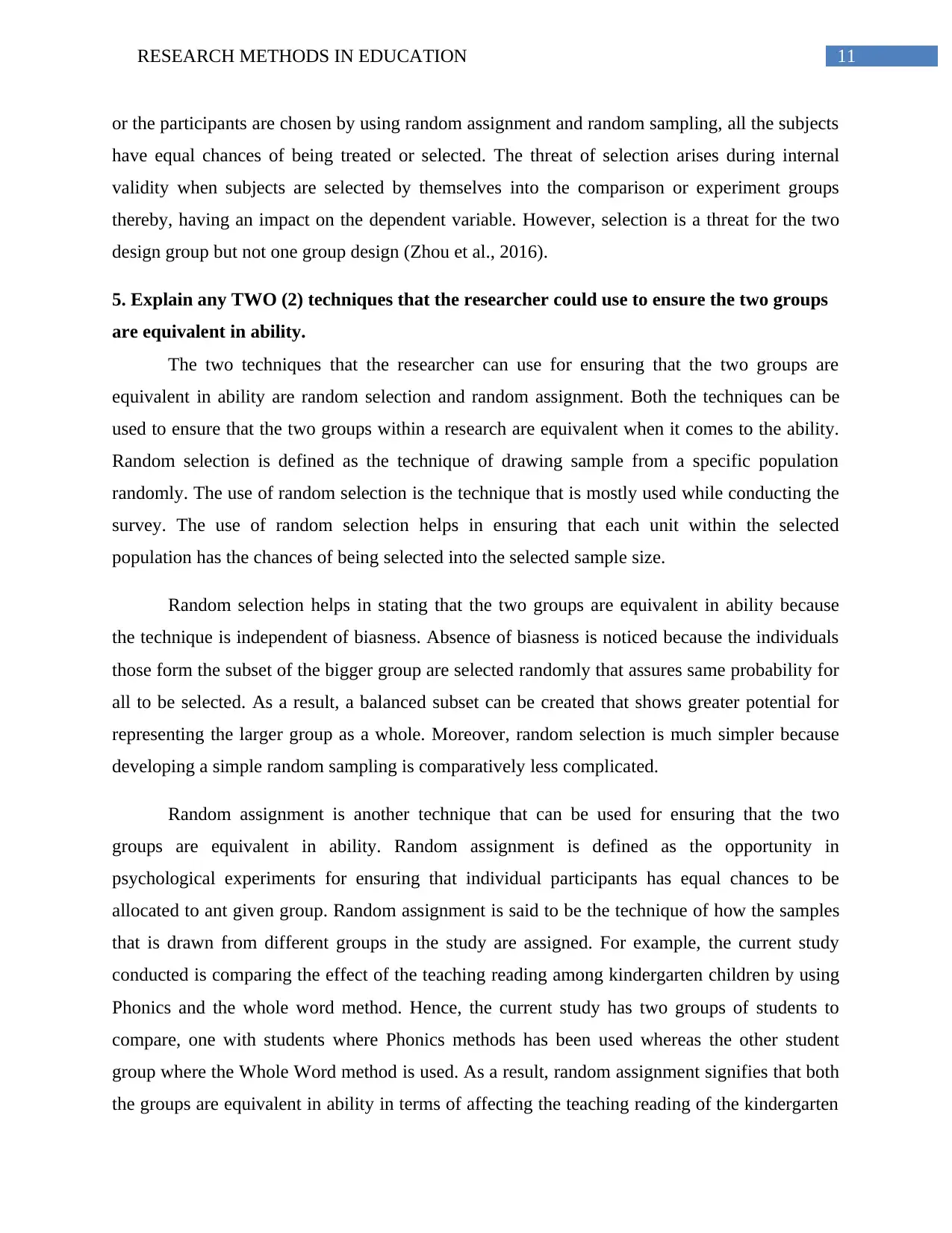
11RESEARCH METHODS IN EDUCATION
or the participants are chosen by using random assignment and random sampling, all the subjects
have equal chances of being treated or selected. The threat of selection arises during internal
validity when subjects are selected by themselves into the comparison or experiment groups
thereby, having an impact on the dependent variable. However, selection is a threat for the two
design group but not one group design (Zhou et al., 2016).
5. Explain any TWO (2) techniques that the researcher could use to ensure the two groups
are equivalent in ability.
The two techniques that the researcher can use for ensuring that the two groups are
equivalent in ability are random selection and random assignment. Both the techniques can be
used to ensure that the two groups within a research are equivalent when it comes to the ability.
Random selection is defined as the technique of drawing sample from a specific population
randomly. The use of random selection is the technique that is mostly used while conducting the
survey. The use of random selection helps in ensuring that each unit within the selected
population has the chances of being selected into the selected sample size.
Random selection helps in stating that the two groups are equivalent in ability because
the technique is independent of biasness. Absence of biasness is noticed because the individuals
those form the subset of the bigger group are selected randomly that assures same probability for
all to be selected. As a result, a balanced subset can be created that shows greater potential for
representing the larger group as a whole. Moreover, random selection is much simpler because
developing a simple random sampling is comparatively less complicated.
Random assignment is another technique that can be used for ensuring that the two
groups are equivalent in ability. Random assignment is defined as the opportunity in
psychological experiments for ensuring that individual participants has equal chances to be
allocated to ant given group. Random assignment is said to be the technique of how the samples
that is drawn from different groups in the study are assigned. For example, the current study
conducted is comparing the effect of the teaching reading among kindergarten children by using
Phonics and the whole word method. Hence, the current study has two groups of students to
compare, one with students where Phonics methods has been used whereas the other student
group where the Whole Word method is used. As a result, random assignment signifies that both
the groups are equivalent in ability in terms of affecting the teaching reading of the kindergarten
or the participants are chosen by using random assignment and random sampling, all the subjects
have equal chances of being treated or selected. The threat of selection arises during internal
validity when subjects are selected by themselves into the comparison or experiment groups
thereby, having an impact on the dependent variable. However, selection is a threat for the two
design group but not one group design (Zhou et al., 2016).
5. Explain any TWO (2) techniques that the researcher could use to ensure the two groups
are equivalent in ability.
The two techniques that the researcher can use for ensuring that the two groups are
equivalent in ability are random selection and random assignment. Both the techniques can be
used to ensure that the two groups within a research are equivalent when it comes to the ability.
Random selection is defined as the technique of drawing sample from a specific population
randomly. The use of random selection is the technique that is mostly used while conducting the
survey. The use of random selection helps in ensuring that each unit within the selected
population has the chances of being selected into the selected sample size.
Random selection helps in stating that the two groups are equivalent in ability because
the technique is independent of biasness. Absence of biasness is noticed because the individuals
those form the subset of the bigger group are selected randomly that assures same probability for
all to be selected. As a result, a balanced subset can be created that shows greater potential for
representing the larger group as a whole. Moreover, random selection is much simpler because
developing a simple random sampling is comparatively less complicated.
Random assignment is another technique that can be used for ensuring that the two
groups are equivalent in ability. Random assignment is defined as the opportunity in
psychological experiments for ensuring that individual participants has equal chances to be
allocated to ant given group. Random assignment is said to be the technique of how the samples
that is drawn from different groups in the study are assigned. For example, the current study
conducted is comparing the effect of the teaching reading among kindergarten children by using
Phonics and the whole word method. Hence, the current study has two groups of students to
compare, one with students where Phonics methods has been used whereas the other student
group where the Whole Word method is used. As a result, random assignment signifies that both
the groups are equivalent in ability in terms of affecting the teaching reading of the kindergarten
⊘ This is a preview!⊘
Do you want full access?
Subscribe today to unlock all pages.

Trusted by 1+ million students worldwide
1 out of 27
Related Documents
Your All-in-One AI-Powered Toolkit for Academic Success.
+13062052269
info@desklib.com
Available 24*7 on WhatsApp / Email
![[object Object]](/_next/static/media/star-bottom.7253800d.svg)
Unlock your academic potential
Copyright © 2020–2025 A2Z Services. All Rights Reserved. Developed and managed by ZUCOL.


